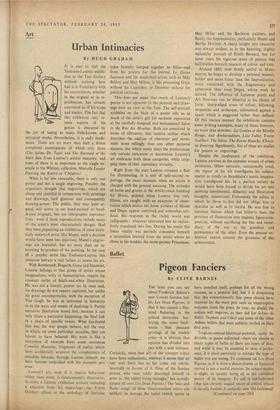Art
Urban Intimacies
By HUGH GRAHAM What is far less excusable, there is only one poster and not a single engraving. Possibly the organisers thought that engravings, which are cheap and plentiful in comparison with paintings and drawings, lack glamour and consequently drawing-power. The public, they may have ar- gued, will queue to see hand-painted or hand- drawn originals, but not lithographic reproduc- tions---even if those reproductions include many of the artist's most characteristic designs. Had they been sorganising an exhibition of some essen- tially malcrisch artist, like Manet. such a decision would have been less injurious; Manet's engrav- ings are beautiful, but no more than an in- teresting by-product of his painting. In the case of a graphic artist like Toulouse-Lautrec this omission betrays a real failure to assess his art.
With Rembrandt, Hogarth,Goya and Daumier, Lautrec belongs to that group of artists whose imaginations, witty or humanitarian, require the constant outlet of black-and-white illustration. He was not a literary painter (as he once said, his drawings do not require captions), but unlike his great contemporaries, with the exception of Van Gogh, he was as interested in humanity as in the ways and means of depicting it. Purely narrative illustration bored him, because it can only relate a particular happening, the final link in a chain of specific events. What fascinated him was the way people behave, not the way in which, on some particular occasion, they are known to have behaved. His work is like a succession of excerpts from some enormous Comedic Humaine, fragments of reality which have accidentally acquired the completeness of anecdote because, through Lautrec himself, we have become enthralled with his dramatis per- soma'.
Lautrec's art, even if it depicts behaviour rather than event, is fundamentally illustrative; to make a Lautrec exhibition without including a selection from his engravings--the Yvette Guilbert album or the anthology of feminine types brutally lumped together as Elles—and from his posters for the journal Le Divan Japonais and for music-hall artists such as May Belfort and May Milton, is like presenting Goya without his Caprichos, or Daumier without his political cartoons.
This does not mean that much of Lautrec's genius is not apparent in the pictures and draw- ings now on view at the Tate. The self-portrait scribbled on the back of a poster tells us as much of the artist's gift for sardonic exposition as the carefully designed and monumental Salon in the Rue des Moulins. Both are conceived in terms of silhouette, that incisive outline which describes the oddities of character and move- ment more tellingly than any other pictorial element, but which rarely plays the predominant role outside caricature or decoration. Lautrec's art embraces both these categories, while strip- ping them of.their customary triviality.
Right from the start Lautrec revealed a flair for illuminating, in a sort of split-second re- portage, the exact moment when an action is charged with the greatest meaning. The attitudes of horse and groom in the Artilleryman Saddling his Horse, painted when Lautrec was only fifteen, are caught with an exactness of obser- vation which makes the horse pictures of Manet and Degas appear contrived and somewhat arti- ficial. His response to the visible world was calligraphic: whatever interested him he instinc- tively translated into line. During his youth this linear vitality was partially concealed beneath a naturalism learned from the artists whom he chose as his models: the horse-painter Princeteau, then Millet and the Barbizon painters, and finally the Impressionists, particularly Manet and Berthe Morisot. A sharp insight into character was always evident, as in the haunting, slightly unhealthy portrait of Emile Bernard, but for some years his vigorous sense of pattern was half-hidden beneath nuances of colour and tone.
Around 1887, now firmly settled in Mont- martre, he began to develop a personal manner, bolder and more linear than the Impressionists, more concerned with the fragmentary and ephemeral than even Degai, whose work he adored. The influence of Japanese prints and Art Nouveau can be detected in his choice of form : sharp-edged areas of colour, billowing, serpentine and arabesque, silhouetted against a. space which is suggested rather than defined. Of this mature manner the exhibition contains some striking examples, many of them, however, no more than sketches: La Goulue at the Moulin Rouge, Aux Ambassadeurs, Lole Fuller, Yvette Guilbert, The Salon, The Revue Blanche, Choco- lat Dancing. Significantly, five of these arc studies for posters or engravings.
Despite the inadequacy of the exhibition, Lautrec survives as the supreme witness of urban intimacies. Often sarcastic, occasionally cruel, the vigour of his wit transfigures his subject- matter as totally as Baudelaire's poetic imagina- tion transfigured his. In a puritan society he would have been forced to divide his art into painting (sentimental, didactic) and illustration (naughty, censorious). Fortunately the milieu in which he chose to live did not oblige him to moralise as well as to record. He was free to translate themes which had hitherto been the province of illustration into majestic figure-com- position, without sacrificing the bite and imme- diacy of the one to the grandeur and permanence of the other. Even the present ex- hibition cannot conceal the greatness of this achievement.






































 Previous page
Previous page